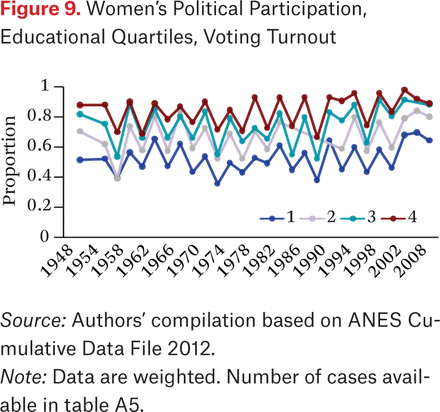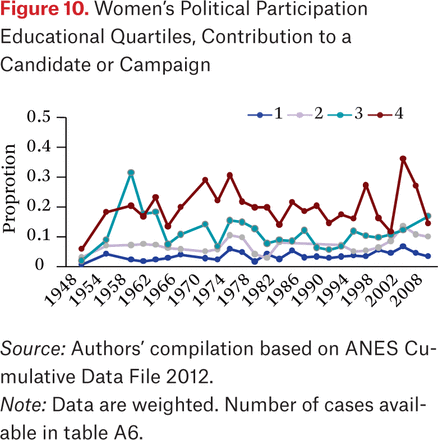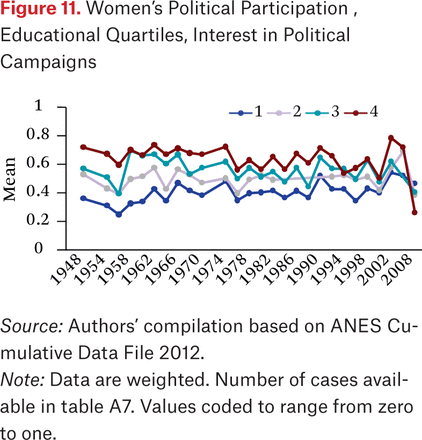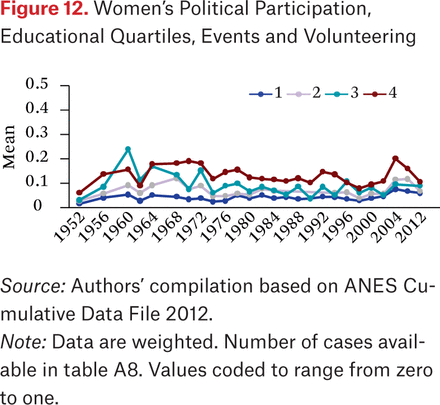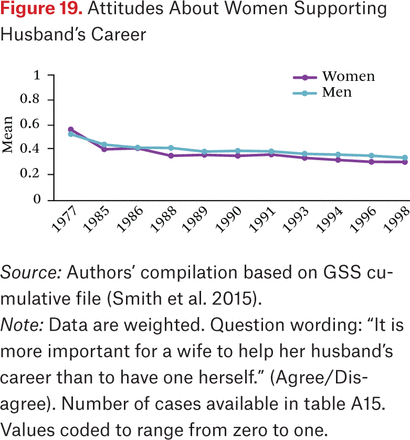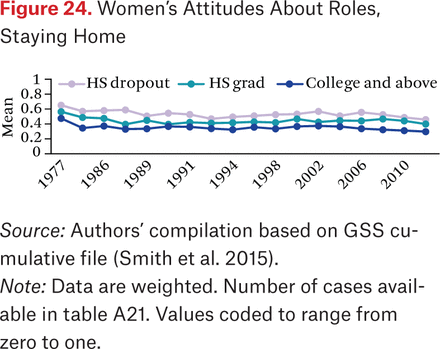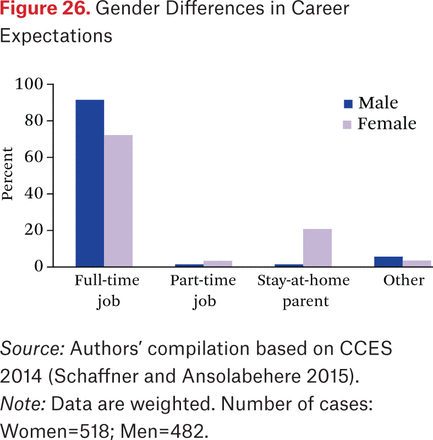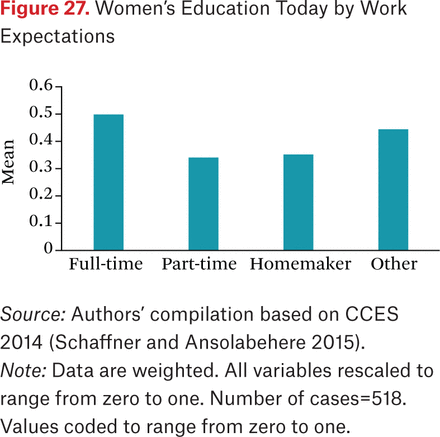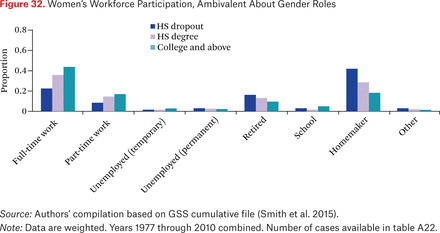Abstract
Over the last forty years, the gap between men and women with respect to labor-market outcomes, paid hours of work, hours working at home, occupations, college majors, and education levels in the United States has narrowed or disappeared. We ask whether these substantial changes in women's lives—changes in precisely the variables that have seemed to matter so much to our understanding of political participation—have enabled women's political action in the United States. We find that they have not, and we suggest that the brakes on the translation of education and occupation into political participation come from continuing ambivalence about jobs and careers. Of course, these ambivalent attitudes may very well reflect a reality about the complications of workforce participation in a world with unequal and limited access to childcare, parental leave, high-paying jobs, and opportunities for career advancement.
Over the last forty years, what was once nearly impossible for many women in the United States—a career with promotion opportunities—became possible and even ordinary. At the same time, the gap between men and women with respect to labor-market outcomes, paid hours of work, hours working at home, occupations, college majors, and education levels in the United States has narrowed or disappeared. As Marth Bailey, Melanie Guldi, and Brad Hershbein put it, “younger women delayed their marriages, increased their educational attainment, and pursued previously male-dominated careers” (2014, 304). These changes were, in part, likely due to the availability of the birth control pill (Goldin and Katz 2002; Bailey 2010). They were also likely enabled by the Kennedy government's contracting policies in the early 1960s, which called for equal hiring and promotion practices within companies (Dobbin 2009). Furthermore, efforts of the civil rights movement and the women's movement to make employment opportunities a right also contributed to these major shifts in women's career opportunities. Along with these changes came a substantial increase in women's educational outcomes.
Many of these shifts in opportunities and expectations for women were ushered in over a single decade; in the early 1960s, a substantial majority of young women imagined their adult lives without jobs and careers. By the late 1960s, only a minority of young women envisioned their adult lives without jobs and careers (Goldin and Katz 2000; Goldin 2004). The effects of this transformation were carried into the next five decades as an increasing number of women went to college and entered the labor market. In this article, we ask whether these changes have shaped individual-level political participation in the United States. As we explain, decades of scholarship have made clear that education and jobs with skill-providing opportunities are strongly related to individual-level political participation. We ask whether these substantial changes in women's lives—changes in precisely the variables that have seemed to matter so much to our understanding of political participation—have enabled women's political action in the United States.
We begin by providing a portrait of these substantial changes with respect to jobs and education. These changes are well known in sociology and economics, but less so in political science, and so have not been taken up in the literatures there. We then turn to accounts of political participation, making clear both what we mean by political participation and how education and jobs play a central role in accounts of political participation. This section sets the stage for the expectation that these fairly dramatic changes in women's education and employment status should translate into fairly dramatic changes in women's political participation. We consider the place of jobs and education separately and ask whether these changes have in fact materialized. We find, quite surprisingly, that some have and some have not. We argue that a range of attitudinal factors—especially attitudes about the roles women should take on—may have dampened the potential impacts of these changes.
A BRIEF PORTRAIT OF THE CHANGE
We begin by outlining the dramatic changes in the employment expectations and education levels of young women in the United States over the latter half of the twentieth century. Beginning in the 1960s, women made an almost complete shift in expectations about their future employment; before this period, most women expected to be at home, working as caretakers and mothers by their mid-thirties. But between the 1960s and 1980s, an increasing proportion of women expected instead to be employed at age thirty-five (Goldin 2006).1
Over this same period, women made enormous gains in educational attainment, helping boost their ability to achieve their new employment expectations. In 1952, a vanishingly small percentage of women had a college degree, and women were some 10 points less likely to complete college than men. By the late 1980s and early 1990s, their rates of college completion equaled men's. In the 2000s, they exceeded them, and by 2010, women were almost 10 points more likely to complete college than men. Today, nearly half of all women have a college degree (U.S. Census Bureau 2011).
As women sought college degrees, and as more jobs became available to women, the kinds of jobs they held changed markedly. In 1952, the overwhelming majority of women reported themselves to be homemakers. Over the past several decades, however, the number of women whose primary job is in the home decreased, and today, only about 20 percent of women report being homemakers. A steadily increasing percentage of women have moved into jobs in the clerical, skilled, and semiskilled service sectors. Women have also moved more into professional and managerial jobs. Although men's occupations have changed over this time as well, with the important exception of agricultural employment, the overall picture men's occupations present is of tremendous stability (ANES 2012; see also Blau and Kahn 2005).
Not all women have had access to these increased levels of education and the ability to move into occupations with more elaborate career ladders. Of course, women today are far less constrained than they were in the 1950s and early 1960s, when fewer than 8 percent had completed four years of college. But even today, stratification among women by education is considerable. In 2014, 11 percent of women over twenty-five did not have a high school diploma; 29 percent terminated their education with only that; 28 percent received some college or an associate's degree; and 20.4 percent received a bachelor's degree (U.S. Census Bureau 2014). As Sara McLanahan makes clear, this stratification by education has made economic inequality between women more severe—partly because, unlike their counterparts, women with more education tend to be married and employed and to delay childbirth (2004).
Our question is whether these large and uneven changes in education and jobs have consequences for political participation. Our answer draws on the frameworks that scholars—political scientists, especially—have used to understand political participation. To help answer the question, we embed the changes we just described in the literature on resources and political participation. From there, we turn to explaining why these impressive structural changes have not translated into higher levels of political participation. We argue that the ambivalence women express about their work and family roles powerfully hampers their willingness and ability to leverage jobs and higher levels of education into political participation.
MODELS OF POLITICAL PARTICIPATION
Whether an individual participates in politics depends on the costs and benefits of participation. We describe the ingredients of a model of participation with this cost-benefit framework in mind. Scholars have found, over and over, that individual-level resources, and especially education and income, are correlated with political participation (Verba, Schlozman, and Brady 1995; Rosenstone and Hansen 1993). Education enables people to be more knowledgeable about politics. Education fosters interest in politics. Education puts people in social networks, gives them cognitive tools, and opens up occupations. It also provides opportunities for increased incomes, making people visible to political mobilizers. Of course, money and education also make it less costly for individuals to participate in politics by opening mobilization opportunities and making potential outcomes more comprehensible.
Political participation is enabled by resources like education. It is also facilitated by a second set of resources—the practical tools people acquire on the job and in religious institutions, through the opportunities to organize meetings, give speeches, participate in meetings, and the like—activities that offer skill-building opportunities. Scholars call this second set of resources civic skills (Verba, Schlozman, and Brady 1995). These also lower the cost of participation by making politics easier to engage in.
These factors—education and civic skills—are the central players in any account of political action. They affect people's sense of being able to do the work of politics and their engagement in the political process. They cumulate inequality in participation, making it ever easier for some to participate in politics and affecting the voices that get spoken and heard in the political arena. They also, therefore, create the tremendous stratification in political participation. Some 70 percent of those in the top quintile of education and income participate in politics; by contrast, only 33 percent of those in the bottom quintile participate (Schlozman, Verba, and Brady 2013, 124).
What do we mean by political participation? We mean activities aimed at speaking to and influencing government in terms of policy or in terms of practice and implementation. Scholars outside political science often focus on two ways of participating in politics: voting and donating money. Political scientists, by contrast, tend to focus on a broad array of activities. In figures 1 through 4, we report participation levels (in this case, the proportion of women who report participating and the average level of participation, where appropriate) using both a broad array of participatory activities and questions asked in comparable ways over time using data from the American National Election Studies (ANES).2 The ANES provides impressive continuity in the study of American national elections. In every presidential year since 1952, the ANES has been made up of a national random sample of U.S. adult citizens surveyed, in-person, by professional interviewers, before and after each election.
Women's Political Participation, Voting Turnout
Our broad array of participatory activities includes voting, contributing to a political candidate or campaign, expressing interest in politics, and an index measure of several types of participatory behavior (such as attending a political event, working for a candidate, or wearing a campaign button). We have just described how factors like education and civic skills acquired in the workplace boost political participation, but in figures 1 through 4, where we have clustered women together regardless of education or occupation status, we see little change over time. In other words, although we might expect women's political participation levels to have risen markedly in correspondence with the large shifts in education achievement and labor-market participation women have experienced over the past fifty or so years, the data presented in figures 1 through 4 do not immediately corroborate such a story. To be sure, changes in levels of women's participation over time are certainly not entirely undetectable, but they are far from dramatic. Herein, we argue, lies a puzzle. Why have women's levels of participation over time appeared not to have mirrored large shifts in the factors that drive participation?
Women's Political Participation, Contribute to a Candidate or Campaign
Women's Political Participation, Interest in Political Campaigns
Women's Political Participation, Events and Volunteering
STRATIFICATION BY EDUCATION AND OCCUPATION
One expectation might be that stratification by education and occupation explains why we do not observe larger shifts in participation over time. As we described, not all women have made the gains that would lead to higher levels of political participation. To more fully unpack trends in political participation among women over time, we use the ANES time series—comparing rates of participation in a number of domains among women without high school diplomas, those who graduated high school, and those who obtained at least a college degree. We might expect that, as norms and expectations about women's college and career options changed over time, women with more education would increasingly diverge in their rates of political participation compared with women with less education.
We present results of this overtime analysis in figures 5 through 8. When we consider the proportion of women who have contributed to campaigns or who have voted, for instance, we find a consistent and somewhat surprising trend. It is true that today women with more education participate in these activities more often than those with less. Yet panning over the time series, we can see that both the slope of these lines and the distance between them has remained relatively stable. In other words, in terms of political participation, the women with the most education have always looked different than women with less. No dramatic shift is evident in the rates with which women at each level of education engaged in political activities over the period of large changes.
Women's Political Participation, Education, Voting Turnout
Women's Political Participation, Education, Contribute to a Candidate or Campaign
Women's Political Participation, Education, Interest in Political Campaigns
Women's Political Participation, Education, Events and Volunteering
Of course, the graphs take education as an absolute; they treat the credential as the key variable of interest. We could, instead, treat education as a relative variable, in comparison with the educational level of others in the society. In other words, perhaps a college degree has a different meaning and value depending on whether a college degree is a rare achievement or a more common achievement in society. We explore this possibility by looking again at the same data, this time using education in quartiles in figures 9 through 12. What we see is that the stratification is not so much about relative education as it is about absolute education. Although those at the top participate more than those at the bottom, the quartile approach obscures the work the credentials do to stratify the population.
Women's Political Participation, Educational Quartiles, Voting Turnout
Women's Political Participation Educational Quartiles, Contribution to a Candidate or Campaign
Women's Political Participation, Educational Quartiles, Interest in Political Campaigns
Women's Political Participation, Educational Quartiles, Events and Volunteering
That college degrees matter in roughly the same way now as they did in years past is perhaps surprising, and especially so in the face of the increasing heterogeneity of women who receive a college degree. College completion stratifies the population as crisply now, when nearly half of all women have the degree, as it did when only a tiny percentage did, and this continuity is in many ways startling.
Of course, education is only one part of the large change of the past decades, only one component of the way women have made good on their expectations. The second way they have made good is in terms of jobs and careers. As women have moved into jobs with skill-giving opportunities and as employment has become normative in adult women's lives, have jobs and employment come to stratify differently now than they did in the past? We face some data limitations with respect to women and full-time jobs, and so we focus here (in figures 13 through 16) on differentiating participation over time by three kinds of job classifications—professional and managerial jobs, clerical and sales jobs, and homemakers.
Women's Political Participation, Professional Status, Voting
Women's Political Participation, Professional Status, Contribution to a Candidate or Campaign
Women's Political Participation, Professional Status, Interest in Political Campaigns
Women's Political Participation, Professional Status, Events and Volunteering
The story here is remarkably similar to the story for education. Women in professional and managerial jobs—jobs that provide precisely the kind of civic skills that enable political action—have always participated more than have women in clerical and sales jobs and women at home. This continues for the entire fifty-year series, despite the tremendous change in access to these jobs for women. In other words, no change over time is evident in the relationship between education or occupation and political participation.
To view this another way, we pool data from the ANES over the entire time series from 1970 to the present and estimate political participation among women as a function of education, occupation, and the interaction between these factors and year indicator variables. We also control for age, income, church attendance, employment status, and marital status. In figure 17, we plot the coefficients with their respective standard errors for both the interaction between year and education and year and professional occupation. The results tell a consistent story. The relationship between education and professional occupation is not moderated by year. Instead, the relationship between these variables and political participation is quite consistent over time.
Education, Occupation, and Women's Political Participation
Again, we find this continuity in the face of the tremendous changes in selection into these jobs over time to be surprising. As with education, the association appears to come from the experience, not from the process of selection. This relationship seems, again somewhat unexpectedly, not to be muddied by the changes in the heterogeneity within these categories.
ATTITUDES ABOUT THE ROLE OF WOMEN IN THE WORKPLACE
We turn now to the third way women could make good on the dramatic changes in their early expectations about labor-force attachment, with respect to attitudes about the role of women in the workplace. Women are of course in the workforce in great numbers, and increasingly in professional and managerial occupations. Yet men's presence in the workforce is seen as natural, and the question of staying or leaving the workplace is not ever-present. We ask, then, whether women—or at least some women—come to see their presence in the workplace as normative and unproblematic.
Although we do not have measures of women's satisfaction with their jobs and their levels of commitment to the workplace, we do have measures over time of whether women and men view women's presence in the workplace as normative and unproblematic. Have women made good on this third outcome, their views about whether women are comfortably in the workplace? To what extent have women's views about women's workforce involvement remained ambivalent?
Given the tremendous attention paid to discussions of opting out (Belkin 2003; Stone 2007) and to what Betsey Stevenson and Justin Wolfers call the “paradox of declining female happiness” (2009), and given the emerging literature on gender identity within labor-force economics (Bertrand 2011; Fortin 2015), we have reasons to expect that women in the United States have not lost their ambivalence.
In the United States, debates about gender have centered largely on whether women should be relegated to the private sphere, at home, with their family. In the midst of the women's rights movement in the early 1970s, when significant attention was paid to gender equality issues, scholars developed survey measures to gauge the extent to which individuals subscribed to the traditional belief that the role of women was in the home, or whether they adopted more egalitarian views about women's place (Spence and Helmreich 1972). We might expect that over the past several decades, as women have increasingly left the home, earned college degrees, and entered the labor market en masse, attitudes about women's roles would shift dramatically toward a more egalitarian position.
Alternatively, and consistent with the opting-out literature, we might anticipate less change in attitudes than the enormous shift in women's behaviors might suggest. In part, changes in attitudes about women's proper roles might be modest because the characteristics we attribute to men and women are largely seen as immutable and essential. In other words, particular qualities people generally ascribe to women—that they are inherently caretakers, nurturers, and meant to be at home raising children—are not attitudes that have necessarily been abandoned (Goffman 1977). We suspect that such traditional beliefs may very well be hampering the extent to which women's increased resources boosted political engagement.
We can observe whether such attitudinal shifts have occurred by examining responses to survey questions often employed to gauge attitudes about women's roles. We examine average responses to such questions over time among both men and women, for good reason. Women's decisions about whether to work, to participate in politics, to pursue careers, and more are inextricably linked to the attitudes possessed by men—both men they encounter in their daily lives, and men who influence the policies and practices that give women options and opportunities to pursue such activities. Thus, to examine attitudes over time, we turn to the General Social Survey (GSS), a nationally representative survey that has featured questions about women's roles routinely since 1977 (Thornton, Alwin, and Camburn 1983; see also Fortin 2015). We center our attention not on all questions the surveys have asked about women's roles, but rather those that focus most intensively on acceptance and ambivalence about women's workforce participation.
We begin with the most pointed question in the battery, the question about the extent to which individuals agree or disagree that a working mother can establish just as warm and secure a relationship with her children as a mother who does not work. In figure 18, we plot the mean response to this question on a scale recoded such that values range from zero to one, with higher values representing a more traditional view.
Attitudes About Working Mothers
The results are striking. We can see that despite a discernible drop toward the end of the 1970s and into the 1980s, such that both men and women are somewhat more supportive of women's employment, the slope of the lines remains markedly unchanged. There is also a noteworthy gender gap between men and women, with women more likely to endorse egalitarian gender roles. On average, however beliefs about the role of women as caretakers have persisted among both men and women. Furthermore, such attitudes seem largely unmoved by the overwhelming gains women have made in terms of educational attainment and labor-market participation. Even in 2012, a sizable portion of both men and women maintained that working mothers cannot establish the same relationships with their children as mothers who do not work.
A similar trend emerges when we look at other questions gauging attitudes about women's roles. When asked whether it is more important for a wife to help her husband's career than to have one herself, we do see a slight drop in endorsement of this notion over the course of the time series (figure 19), but not nearly as dramatic of a change as we might expect given the huge shift in women's work lives.
Attitudes About Women Supporting Husband's Career
The same trend is present when asked whether children suffer when a mother works (figure 20), and whether it is better for a man to be the achiever outside the home and for the woman to take care of the family (figure 21). In both instances, we see slight movement away from the more traditional perspective in the late 1970s, and then attitudes are mostly stable.
Attitudes About Children if Mother Works
Attitudes About Men Working and Women Staying Home
Perhaps most surprisingly, when we look at these same attitudes by level of education in figures 22 through 25, it is clear that what changes there have been toward less ambivalence about women's employment have come to women at all levels of education in fairly even measure. For women at each of the three levels of education, attitudes changed most markedly between 1977 and 1988, and then leveled off. Although it is true throughout the series that college-educated women are more supportive of women's labor-force participation, no group changed especially dramatically. It is also true that a large proportion of all of these groups believe that children suffer when their mother works.
Women's Attitudes About Roles, by Working Mothers
Women's Attitudes About Roles, Children
Women's Attitudes About Roles, Staying Home
Women's Attitudes About Roles, Husband's Career
For the most part, then, women and men have not become significantly more comfortable and less conflicted about women's employment. A sizable subset of both men and women in the United States still hold more traditional views about women's place, or remain at least ambivalent about whether women are better suited for the private sphere than the public. This ambivalence translates, we suspect, into workforce outcomes, outcomes that, in our framework, shape the opportunities women have to develop politically relevant skills on the job.
This ambivalence about the workplace is fairly widespread, but it also stratifies workforce outcomes, and stratifies those outcomes over and above the stratification from education. The following charts reinforce what we already know about the way that education stratifies presence in the workforce. College-educated women are notably more likely to be working full time than high school graduates or women with less than a high school diploma. The other side of the story is also true: college-educated women are notably less likely to be homemakers than women with less education. Views on women's place stratify these outcomes even more. Women with college degrees who believe that women are appropriately in the workforce are some 30 points more likely to be in the workforce full time than their counterparts who believe differently. Those who are ambivalent are in between but are a bit closer to conservative than liberal women here.
This ambivalence about women's place makes some trouble for the full realization of young women's expectations. We explored these relationships by collecting data on both men's and women's attitudes and expectations using the 2014 Cooperative Congressional Election Survey (CCES). Our data were drawn from a nationally representative sample of 431 men and 569 women, who were asked questions about gender, expectations, attitudes, employment, and political preferences. The preelection survey was fielded in September and October 2014. We returned to reinterview this sample in a postelection study, which was fielded in November and December 2014.
These data make clear that women who at age eighteen expected to be in the workforce full time acquired more education than those women who did not expect to be in the workforce full time. They made good on the first part of their expectations. The next two charts illustrate this point. First, in figure 26, we see that, as in the Goldin data (2005), most women report that they expected to be in the workforce. In figure 27, we see that women who expected to be in the workforce full time acquired more education than did women who did not. In figure 28, we see that women who expected to be in the workforce full time achieved jobs that were more likely to provide the kind of on-the-job training that can make participation less costly. That is, they were more likely to work at a job where they gained the sort of civic skills—like serving on committees, organizing meetings, or giving presentations—that they can carry into the political world.
Gender Differences in Career Expectations
Women's Education Today by Work Expectations
Women's Civic-Related Job Skills by Expectation
However, these women had more trouble making good on their expectations about employment. When we look at the difference between women's employment expectations at eighteen and their employment today in these 2014 data (figure 29), it is clear that just under 40 percent of the women who expected to be full time are full time. Furthermore, across the range of education, a sizable proportion of women cut their work hours back to care for their families; this is a long-time standard result (figure 30) (see Pleck 1977). Although a good deal of women's ability to make good on their expectations about their employment varies very little across the dimensions of stratification we examine here, one dimension does seem to condition their ability to follow through on their expectations—their views about women in the workplace. Women who are less conflicted on the issue are notably more likely to work full time (figures 31 through 33) (see also Correll 2004; Farre and Vella 2013).
Women's Career Expectations Versus Later Employment
Women's Decisions to Cut Back on Work to Care for Family
Women's Workforce Participation, Conservative About Gender Roles
Women's Workforce Participation, Ambivalent About Gender Roles
Women's Workforce Participation, Liberal About Gender Roles
We suspect that this ambivalence, or this sense that women's workforce participation is problematic for families and children and, in fact, workplaces—a worry that is centrally focused on the sense that children's lives are best when mothers are home—has consequences that reach beyond whether individual women achieve their expectations. This ambivalence also ought to undermine support for policies that might play a role in translating education into jobs—policies that might make it easier for women to keep, hold, and advance in their positions. We focus here on four policies. We ask about the relationship between women's views on women's employment and their support for federally provided childcare, parental leave, equal pay for equal work, and federal efforts to prevent job discrimination against women.
Using our 2014 CCES data, we examine the relationship between beliefs about women's proper place and support for these policies. We measure attitudes toward women by scaling together items designed to assess beliefs about women's proper place. Survey respondents were asked the extent to which they agree or disagree with the following three statements:
A working mother can establish just as warm and secure a relationship with her children as a mother who does not work.
Men should not be expected to spend the same amount of time on household chores as women.
I would be equally comfortable having a woman as a boss as I would a man.
We estimate the extent to which support for policies aimed at easing women's path into and presence within the workforce is a function of these attitudes about women's place, controlling for a number of factors including employment status, age, education, marital status, income, conservative church membership (respondent identifies as Catholic, Baptist, or Mormon), solidarity with other women, and party identification. All variables in our models are coded to range from zero to one.
Table 1 provides the results of our ordinary least squares regression estimations, with our policy items regressed on the variables described. With the exception of support for federal spending for childcare (though results are in the expected direction), the results are quite consistent; in each case, more conservative views about women's place significantly decrease support for our workplace-related policies. Furthermore, the associations are powerful, reducing support by approximately 20 percent on the zero to one scale in each case.
Attitudes toward Promoting Women's Workforce Participation
In short, these results provide further evidence for the powerful role attitudes about the proper place of women have in terms of depressing what otherwise might be more sweeping consequences of gains in education and jobs. The persistence of these more traditional attitudes undermines support for policies that make it easier for women to enter into and remain in the workforce.
CONCLUSION
Our analyses suggest that women's changing expectations—and especially the ways they translated into more women with college degrees and more women with professional and managerial jobs—mattered a lot for women's political participation. They helped enable higher levels of education and more professional occupations, both of which provide skills that enable political participation. Nevertheless, what is also clear is that attitudes about women's place have put brakes on the translation of these opportunities into participation-relevant resources for women. Our data suggest that some of these brakes come from the tradeoffs women make to care for their families, and from ideas about women's place that foster ambivalence when it comes to embracing jobs and careers.
Taken together, these results offer a valuable portrait of the changes in women's participation-relevant skills and resources over the last fifty years. They do a second thing, as well. They offer some evidence in favor of a treatment as opposed to selection view of education as a resource for political action. Despite the large changes in access to education and in relative education levels in the United States for women and for men, education stratifies participation today roughly as it did fifty years ago. Previous literature, literature not focused on the changes in women's lives, has reached conflicting conclusions on whether education's consequences are a product of selection processes. Some have found that education, especially attending college, works as a treatment, boosting political participation (Sondheimer and Green 2010; Card 1993; Acemoğlu and Angrist 2001; Dee 2004; Hillygus 2005). Others, however, argue that education's effects are about selection, that education is a proxy for other attitudes and socialization experiences that more directly affect political participation and engagement (Kam and Palmer 2008; Tenn 2007; Berinsky and Lenz 2010; Jennings and Niemi 1981). Our results offer suggestive evidence for the education-as-treatment side of the argument, and they offer hints about a potential strategy for using these changes in women's lives to investigate this question, yet again.
These data also make clear the value of pursuing the question of attitudinal brakes on women's workforce participation. Scholars have argued that gender is especially essentialized; that gender hierarchy is so structurally and attitudinally embedded that it is not disappearing any time soon (Haslanger 2000). We see in our data some confirmation of this attitudinal embedding; many women endorse more traditional roles for women and express ambivalence about entering and remaining in the workforce, ultimately making them less likely to obtain the skills and interests that promote political engagement.
Our data provide further clues that, for many women, commitment to the workforce is tenuous. We asked women in our 2014 CCES sample whether they had ever considered cutting back on employment, and the results of our open-ended question offer a portrait of women's attitudes about both work and family. Many women at even the highest levels of education expressed a desire to stay at home with their children. Those who remained in the workforce claimed to do so because they felt economic pressure to continue working. One college-educated woman wrote, for instance, “I decided to continue working because I can't afford to stay at home with my son.” Another said she “considered it but could not afford to do it.” Even many women who did drop out of the workforce couched their explanation in economic terms, as one women explained, “I took nine years off; however, I was able to do so because my husband had an excellent job.”
In this way, the women at the top of the education stratum look strikingly like those with the least education. Many of the women who did not graduate high school or received only their high school diploma echoed these sentiments, providing comments such as “I would have considered it if we could have afforded it.” And across the education spectrum, many women reported staying at home simply because they believed it was most beneficial to their children. They made comments such as one woman who had attended some college explained, “I did not work after I had my children. I would not have had children if I had to work. My children were my job.” One high school graduate said, “When my children were born I stayed at home. My mother always said that if you were going to have kids they deserved at least one full-time parent. She was right, they did.” A woman with a postgraduate degree stated, “I quit my job to stay at home with my kids because it was in their best interests.” Even a sizable portion of the women who continued to work for financial reasons still emphasized the importance of being at home:
If I could afford it, I would have (and still would) gone part-time to help juggle my parenting with my career, but we need my full income. Also, I've taken PTO frequently over the years to help my terminally ill parents (now both deceased) and it would have been better to be able to take leave without worrying about money to devote more time there. It's all about the money.
To us, these responses read like the attitudinal residues of ambivalence. They show the significant pull women feel toward the private sphere, into family life as primary caregivers. What stands out, however, is how rarely our respondents seemed to be similarly compelled by their jobs or careers; very few expressed a desire to stay in the workforce for reasons beyond economic necessity. The respondent who said, “I considered being a stay-at-home mom once we had children ... I decided I wanted to continue working because I find joy in doing my job and would miss it” was an outlier in our data.3
We see the conflict expressed by many women in our data as another illustration of a brake on women's workforce participation. What our findings suggest, then, is that regardless of women's expectations, their levels of education, and their labor-market participation, attitudes about women's place and a strong desire to assume the role of caretakers—coupled with a lack of enthusiasm for jobs or careers—likely dampen the more sweeping changes in political behavior we might expect to have observed over the past sixty years. Of course, these attitudes may very well reflect a reality about the complications of workforce participation in a world with unequal and limited access to childcare, parental leave, high paying jobs, and opportunities for career advancement.
APPENDIX
Weighted Sample Size for “Voted” Variable
Weighted Sample Size by Category for “Contribute” Variable
Weighted Sample Size by Category for “Electoral Interest” Variable
Weighted Sample Size by Category for “Index: Attending Political Events, Working for a Candidate, or Wearing a Button” Variable
Weighted Sample Size by Category for “Voted” Variable by Education Quartiles
Weighted Sample Size by Category for “Contribute” Variable by Education Quartiles
Weighted Sample Size by Category for “Electoral Interest” Variable by Education Quartiles
Weighted Sample Size by Category for “Index: Attending Political Events, Working for a Candidate, or Wearing a Button” Variable by Education Quartiles
Weighted Sample Size by Category for “Voted” Variable
Weighted Sample Size by Category for “Contribute” Variable
Weighted Sample Size by Category for “Electoral Interest” Variable
Weighted Sample Size by Category for “Index: Attending Political Events, Working for a Candidate, or Wearing a Button” Variable
The Interactive Effect of Year with Education and Professional Occupation Among Women
Weighted Sample Size by Gender for Attitudes About Working Moms
Weighted Sample Size by Gender for Belief That Wife Should Help Man's Career
Weighted Sample Size by Gender for Belief That Kids Suffer if Mother Works
Weighted Sample Size by Gender for Belief That Man Should Work, Woman Should Stay Home
Weighted Sample Size by Category for Women's Attitudes About Working Moms, by Educational Attainment
Weighted Sample Size by Category for Women's Attitudes About Kids Suffer if Mother Works by Educational Attainment
Weighted Sample Size by Category for Women's Attitudes About Wife Should Help Husband's Career by Educational Attainment
Weighted Sample Size by Category for Women's Attitudes About Better for Man to Work by Educational Attainment
Weighted Sample Size by Education for Women's Workforce Participation Stratified by Education and Attitudes About Gender Roles
Attitudes Toward Promoting Women's Workforce Participation
FOOTNOTES
↵1. We have some insight from existing work about the impetus for these changes; Kathleen Gerson (2011), for example, in her interviews with young women, makes clear that some of this change in expectations is likely about the opportunities available. More recently, however, if Gerson's interviews are any guide, some of the expectations are about women's desire for independence and long-run financial security.
↵2. We combine both blacks and whites in this analysis and the others throughout this chapter. Although participation among blacks is somewhat more depressed than it is for whites, the overall trends described here hold true across racial groups.
↵3. Interestingly, few men expressed such sentiments either. Yet the men in our sample also described juggling work with family or needing to care for family far less frequently than the women. These responses suggest that while individuals, regardless of gender, are not, perhaps, overwhelmingly or routinely attached to their jobs, attitudes about the proper role of men and women provide an enduring framework for how individuals talk about their responsibilities.
- Copyright © 2016 by Russell Sage Foundation. All rights reserved. Printed in the United States of America. No part of this publication may be reproduced, stored in a retrieval system, or transmitted in any form or by any means, electronic, mechanical, photocopying, recording, or otherwise, without the prior written permission of the publisher. Reproduction by the United States Government in whole or in part is permitted for any purpose. Direct correspondence to: Ashley Jardina at ashley.jardina{at}duke.edu, Duke University Department of Political Science, 140 Science Drive, 208 Gross Hall, Campus Box 90204, Durham, NC 27708; and Nancy Burns at nburns{at}umich.edu, The University of Michigan Department of Political Science, 5700 Haven Hall, 505 South State Street, Ann Arbor, MI 48109.
Open Access Policy: RSF: The Russell Sage Foundation Journal of the Social Sciences is an open access journal. This article is published under a Creative Commons Attribution-NonCommercial-NoDerivs 3.0 Unported License.










